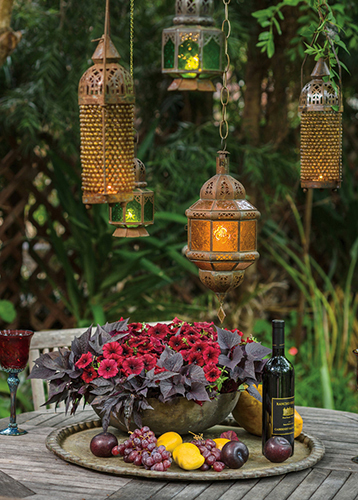Are you captivated by the dark elegance and mysterious allure of gothic aesthetics? Do you dream of transforming your garden into a realm of shadows and enchantment? Welcome to the world of gothic garden decor! In this extensive guide, I’ll share my personal experiences, expert tips, and creative ideas for crafting a gothic garden that resonates with your unique style.
What is Gothic Garden Decor?
Gothic garden decor is an outdoor design style characterized by its dark themes, intricate details, and romantic elements that evoke a sense of mystery and intrigue. With roots tracing back to the Gothic architectural movement, this style marries nature with a touch of the macabre, creating enchanting spaces that feel both timeless and otherworldly.
Key Characteristics of Gothic Garden Decor
- Dark Color Palettes: Rich hues like deep reds, blacks, purples, and even metallics.
- Intricate Designs: Ornate patterns in furniture and accessories.
- Mysterious Lighting: Use of candlelight and low, ambient lighting.
- Natural Elements: Incorporating stones, wrought iron, and lush foliage.
- Symbolic Features: Incorporating symbolism from Gothic literature and art.
Why Choose a Gothic Garden Decor Style?
As someone who loves all things gothic, I find that this style allows for a unique expression of personality. A gothic garden becomes a sanctuary where you can escape the mundane and immerse yourself in an atmosphere filled with drama and allure.
Personal Experience: My Journey into Gothic Gardening
When I first moved into my house, the backyard was a blank canvas—overgrown and uninspiring. It wasn’t until I discovered gothic garden decor that everything changed. I started with a few key pieces and slowly transformed my space into a mystical haven. Every corner tells a story, and the ambiance is both eerily beautiful and comforting.

Elements of Gothic Garden Decor
1. Furniture and Seating
Choosing the right furniture is crucial for any outdoor space. For a gothic garden, look for pieces with intricate carvings, dark woods, or wrought iron materials.

Comparison Table: Gothic Furniture Options
| Furniture Type | Material | Pros | Cons |
|---|---|---|---|
| Wrought Iron Benches | Wrought Iron | Durable, elegant | Can be heavy |
| Dark Wood Chairs | Hardwood | Classic look | May require maintenance |
| Gothic-Style Gazebo | Wood/Iron | Provides shade | More expensive |
2. Ornamental Structures
Incorporating trellises, arches, and pergolas can enhance your garden’s gothic charm. Decorate them with climbing plants such as night-blooming jasmine or dark-hued roses for a touch of romance.

3. Statues and Sculptures
Statues can act as focal points in your gothic garden. Look for gargoyles, angels, or even mythical creatures to add an air of mystery.
Pros and Cons of Using Statues in Your Garden
- Pros: Adds character and can serve as conversation starters.
- Cons: Initial cost can be high; they may require upkeep.

Plants for a Gothic Garden
Best Plant Choices
When selecting plants, think about color, texture, and fragrance. Some excellent choices for a gothic garden include:
- Black Roses: Classic and dramatic.
- Dark Calla Lilies: Elegant with a gothic twist.
- Heuchera: Known as coral bells, these plants come in deep hues.
- Foxglove: Tall and enchanting, great for height.
- Thorny Plants: Add an element of danger; consider blackberries or thorny roses.
Creating Layers with Plants
The key to a visually interesting garden lies in creating layers. Use tall plants at the back, medium-sized in the middle, and ground cover in the front. This creates depth and ensures every element has room to shine.

Lighting: Setting the Mood
Lighting plays a significant role in creating the gothic atmosphere. Here are some suggestions:
- Candles: Use wrought iron candle holders for a romantic glow.
- String Lights: Opt for warm white or amber tones.
- Lanterns: Hang lanterns from trees or place them along pathways.
Pros and Cons of Different Lighting Options
| Lighting Type | Pros | Cons |
|---|---|---|
| LED String Lights | Energy-efficient, versatile | Can look too modern |
| Candles | Romantic, classic ambiance | Safety concerns, may require frequent replacement |
| Lanterns | Portable, adds character | Limited brightness |

Creating a Focal Point in Your Gothic Garden
A focal point can make your garden feel intentional and curated. Consider a stunning statue, a water feature, or an intricately designed bench as options.
Water Features: Enhancing the Mood
Adding a fountain or pond can create a serene atmosphere. The sound of water adds to the enchanting vibe and attracts wildlife.

Tips for Maintaining Your Gothic Garden
A gothic garden, while beautiful, can require some upkeep. Here are a few maintenance tips:
- Regularly Prune: Keep plants healthy and in shape.
- Clean Statues: Dust and clean periodically to maintain aesthetics.
- Seasonal Changes: Adapt your decor with the seasons (think spooky themes for Halloween).
Frequently Asked Questions (FAQs)
What colors are best for gothic garden decor?
The best colors include deep reds, blacks, purples, and dark greens to create an evocative atmosphere.
How can I incorporate gothic elements into my existing garden?
Start small by adding gothic decor pieces like statues, planters, or even a few dark-hued plants to your current setup.
Is gothic garden decor suitable for small spaces?
Absolutely! You can create a gothic vibe in smaller gardens by focusing on vertical elements and smaller decor pieces.
What plants are considered gothic?
Plants like black roses, dark calla lilies, and thorny varieties contribute beautifully to a gothic theme.
Can I mix gothic decor with other styles?
Yes! Gothic elements can complement other styles, such as Bohemian or Victorian, to create a unique personal aesthetic.
Conclusion: Your Gothic Garden Awaits!
Creating a gothic garden is an exciting journey that combines creativity, personal expression, and a dash of mystery. Whether you are a seasoned gardener or just starting, the elements of gothic decor can transform your outdoor space into an enchanting retreat. Embrace your unique vision and let your gothic garden flourish!